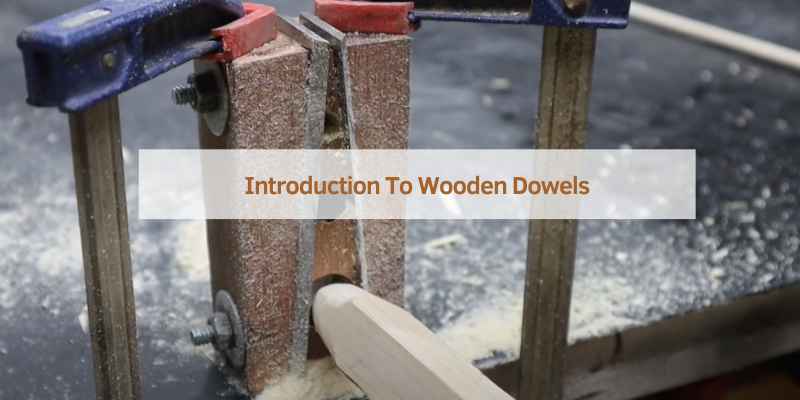To make wooden dowels, use a dowel plate and a wooden mallet to shape the wood. Start by cutting a square blank slightly larger than the desired dowel diameter.
Next, hammer the blank through the appropriately-sized hole in the dowel plate until it forms a dowel. Wooden dowels are versatile and commonly used in woodworking projects. They provide structural support and alignment for furniture, crafts, and more. Making your own wooden dowels allows for customization in size and material.
With the right tools and techniques, creating wooden dowels can be a rewarding and cost-effective DIY skill to have. Let’s explore the process of making wooden dowels in more detail.
Introduction To Wooden Dowels
Wooden dowels are essential components used in woodworking projects to join and align pieces of wood. In this blog post, we will explore the process of making wooden dowels and the advantages of creating your own dowels for woodworking projects. Let’s dive into the world of wooden dowels and learn about their significance in woodworking.
The Role Of Dowels In Woodworking
Wooden dowels play a crucial role in woodworking by providing strong and reliable connections between wood pieces. They are commonly used to reinforce joints, support structural elements, and align wood components during assembly. Dowels enhance the overall strength and stability of wood-based projects, making them indispensable in the woodworking industry.
Benefits Of Diy Dowels
Creating your own wooden dowels offers numerous benefits for woodworking enthusiasts. DIY dowels allow for customization in terms of size, material, and design, providing flexibility for various project requirements. Additionally, making your own dowels can be cost-effective and environmentally friendly, as it enables the use of sustainable wood sources and reduces reliance on commercially produced dowels.

Materials Required
When it comes to making wooden dowels, having the right materials is crucial for achieving the best results. The quality of the wood and the tools used can significantly impact the outcome of the dowel-making process. Therefore, it’s important to carefully select the materials and tools needed for this woodworking project.
Choosing The Right Wood
For making wooden dowels, it’s essential to choose the right type of wood. The ideal wood for dowel making is straight-grained and free from knots, as this ensures a smooth and uniform dowel. Some of the best wood options for making dowels include birch, oak, maple, and beech. These hardwoods are known for their strength and stability, making them perfect for creating sturdy dowels.
Tool Selection For Dowel Making
When it comes to crafting wooden dowels, having the appropriate tools is essential. The following tools are necessary for making wooden dowels:
- Dowel Plate: A dowel plate is a steel plate with various sized holes used for shaping the wooden dowels.
- Handsaw or Table Saw: A saw is required for cutting the wooden stock to the desired length before shaping it into a dowel.
- Wooden Mallet: This tool is used to tap the wooden stock through the holes in the dowel plate to shape it into a dowel.
- Calipers: Calipers are essential for measuring the diameter of the wooden dowel to ensure it meets the required specifications.
- Sandpaper: Sandpaper is used for smoothing the surface of the wooden dowel after shaping it.
Safety First
Prioritize safety by wearing protective gear when making wooden dowels. Ensure proper ventilation and use sharp tools for precise cuts. Remember to follow safety guidelines to prevent accidents and injuries during the woodworking process.
Protective Gear Essentials
Always wear safety goggles, gloves, and ear protection.
Workshop Safety Tips
Keep work area clean, uncluttered, and well-lit.
The Dowel Making Process
To make wooden dowels, you need to follow a specific dowel making process. First, select the wood you want to use and cut it into the desired length. Then, use a dowel maker or a dowel plate to shape the wood into a cylindrical shape.
Sand the dowels to smooth out any rough edges and finish them as desired.
Creating wooden dowels can be an easy and cost-effective way to enhance the quality of your woodworking projects. The dowel making process involves cutting wood to length and shaping the dowel. In this post, we will explore each step in detail.
Cutting Wood To Length
The first step in creating a wooden dowel is cutting a piece of wood to the desired length. You can use any type of wood, but hardwoods like oak, maple, and cherry are often preferred for their strength and durability.
To cut the wood, you can use a handsaw or a table saw. Make sure to measure the wood carefully before cutting to avoid any mistakes. Once you have cut the wood to the desired length, you are ready to shape the dowel.
Shaping The Dowel
Shaping the dowel involves reducing the diameter of the wood until it reaches the desired size. You can use a variety of tools to shape the dowel, including a lathe, a dowel plate, or a hand plane.
If you are using a lathe, secure the wood onto the lathe and slowly turn it while using a chisel to shape the wood. If you are using a dowel plate, place the wood into the plate and use a hammer to pound it through the plate until it reaches the desired size.
Once you have shaped the dowel, sand it down to remove any rough edges or splinters. You can also apply a finish to the dowel to protect it from wear and tear.
In conclusion, the dowel making process involves cutting wood to length and shaping the dowel. By following these simple steps, you can create high-quality wooden dowels that will enhance the strength and durability of your woodworking projects.
Fine-tuning Your Dowels
When it comes to perfecting your wooden dowels, paying attention to the details is crucial. Here, we delve into the essential aspects of fine-tuning your dowels to achieve the best results.
Smoothing Techniques
To ensure a smooth finish, utilize sandpaper of varying grits for gradual refinement.
Ensuring Consistent Diameter
- Measure the diameter frequently during the sanding process.
- Use a dowel plate for precision sizing.
Remember, the key to quality wooden dowels lies in the precision and care you put into the fine-tuning process.
Advanced Techniques
Discover advanced techniques for crafting wooden dowels with precision and expertise. Learn how to create flawless wooden dowels using specialized tools and methods. Elevate your woodworking skills by mastering the art of making high-quality wooden dowels for your projects.
Creating Fluted Or Spiraled Dowels
Adding flutes or spirals to your wooden dowels can add a unique touch to your woodworking projects. To create fluted dowels, you can use a specialized fluting cutter on a lathe. First, mark the locations where you want the flutes to be on the dowel. Then, use the fluting cutter to create the flutes by running it along the marked lines while the lathe is turning the dowel. For spiraled dowels, a spiral cutter head can be used in the same manner to create the desired spiral pattern.
Adding Decorative Elements
To add decorative elements to your wooden dowels, you can use a woodburning tool to etch designs or patterns onto the surface. Additionally, you can use a chisel or carving tool to create intricate designs. Another option is to add contrasting wood inlays to the dowel. This can be done by cutting a groove into the dowel and gluing in a contrasting wood strip.
By utilizing these advanced techniques for making wooden dowels, you can create unique and personalized woodworking projects that will stand out. Whether you choose to add flutes or spirals or decorative elements, these techniques will add a touch of artistry to your woodworking.
Finishing Touches
Once you have successfully created your wooden dowels, it’s time to add the finishing touches to enhance their appearance and durability. This final step involves sanding and polishing the dowels to smooth out any rough edges and give them a polished finish. Additionally, staining and sealing the wood can add color and protection to your dowels, making them more resistant to moisture and wear.
Sanding And Polishing
Sanding and polishing your wooden dowels is essential to achieve a smooth and refined finish. Follow these steps to ensure your dowels look their best:
- Start by using coarse-grit sandpaper to remove any rough spots or imperfections on the surface of the dowels.
- Gradually switch to finer-grit sandpaper, working your way up to achieve a smooth and even surface.
- Make sure to sand the edges and ends of the dowels as well, paying attention to any sharp edges.
- Once you are satisfied with the smoothness, use a soft cloth to remove any dust or debris from the sanding process.
- To add an extra level of polish, you can use a wood polish or wax, applying it with a clean cloth and buffing the dowels until they shine.
Staining And Sealing
If you wish to add color to your wooden dowels or protect them from moisture, staining and sealing is a great option. Here’s how to do it:
- Choose a wood stain that complements your project and apply it evenly to the dowels using a brush or cloth.
- Allow the stain to penetrate the wood for the recommended time specified on the product’s instructions.
- Wipe off any excess stain using a clean cloth, ensuring a consistent and smooth color on the dowels.
- Once the stain has dried completely, apply a wood sealer or varnish to protect the wood from moisture and wear.
- Follow the manufacturer’s instructions for the drying and curing time of the sealer or varnish.
Using Your Homemade Dowels
After successfully making your own wooden dowels, it’s time to put them to good use in your woodworking projects. Incorporating dowels in your projects not only adds strength and stability but also enhances the visual appeal of your creations. In this section, we will explore some creative ways to use your homemade dowels and provide useful tips for their storage and maintenance.
Incorporating Dowels In Projects
Dowels offer endless possibilities for enhancing the structural integrity and design aesthetics of your woodworking projects. Here are a few ideas to inspire you:
- Create strong and seamless joinery by using dowels as an alternative to screws or nails. This technique is commonly used in furniture construction.
- Add decorative accents by incorporating dowels as inlays, creating eye-catching patterns and designs.
- Construct custom handles for cabinets, drawers, or doors by shaping dowels to fit your desired grip.
- Build a sturdy frame for a shelving unit or bookcase using dowels as the supporting structure.
- Craft unique toys, puzzles, or games by combining dowels with other materials, allowing for endless creativity.
Storage And Maintenance Tips
Proper storage and maintenance of your homemade dowels will ensure their longevity and usability. Consider the following tips:
- Store your dowels in a dry and well-ventilated area to prevent moisture absorption, which can lead to warping or splitting.
- Keep your dowels organized and easily accessible by using a dedicated dowel storage rack or container.
- Regularly inspect your dowels for any signs of damage or wear. Discard any dowels that show cracks or significant defects.
- Apply a protective finish, such as wax or varnish, to your dowels to enhance their durability and resistance to moisture.
- When working with dowels, ensure proper alignment and a snug fit by measuring and sanding them as needed.
Common Mistakes To Avoid
To make wooden dowels, it is crucial to avoid common mistakes such as using the wrong type of wood, inadequate sanding, and inaccurate measurements. By carefully selecting the wood, ensuring proper sanding, and precise measurements, you can create strong and durable wooden dowels for various woodworking projects.
Troubleshooting Dowel Imperfections
Dowel making may seem simple, but it is easy to make mistakes that can lead to imperfections in your finished product. Common dowel imperfections include uneven diameter, rough or splintered edges, and crookedness. To avoid these issues, make sure you use a sharp blade or drill bit and sand the dowels after cutting to ensure smooth edges. Additionally, always use a guide to ensure straightness and consistency in diameter.
Learning From Dowel-making Challenges
Dowel making can be a challenging process, but it is important to learn from your mistakes and challenges. If you encounter issues such as splitting or cracking of the wood, try adjusting your blade or drill bit speed, using a different type of wood, or pre-drilling your holes. Don’t be afraid to experiment and try new techniques to find what works best for you.
Summary
In summary, making wooden dowels requires attention to detail and patience. By avoiding common mistakes such as uneven diameter and crookedness, troubleshooting imperfections, and learning from challenges, you can produce high-quality dowels for your woodworking projects. Remember to use the right tools, techniques, and materials, and don’t be afraid to experiment to find what works best for you.

Frequently Asked Questions
How Do You Make Wooden Dowels?
To make wooden dowels, start by selecting a hardwood such as oak or maple. Cut the wood into long, thin strips using a table saw or hand saw. Next, use a dowel plate and a hammer to shape the strips into cylindrical dowels.
Sand the dowels smooth and finish them with a coat of varnish or wax for a polished look.
What Tools Do I Need To Make Wooden Dowels?
To make wooden dowels, you will need several tools. These include a table saw or hand saw for cutting the wood into strips, a dowel plate and hammer for shaping the strips into dowels, sandpaper for smoothing the dowels, and varnish or wax for finishing.
Additionally, clamps and a workbench or table will be useful for securing the wood during the process.
Can I Make Wooden Dowels Without A Dowel Plate?
Yes, you can make wooden dowels without a dowel plate. An alternative method is to use a drill press with a dowel cutting jig. This jig allows you to create dowels by drilling a hole into a larger piece of wood and then cutting it into dowel-shaped pieces.
However, using a dowel plate provides more control and precision in shaping the dowels.
Conclusion
Making wooden dowels is a rewarding and practical skill for any woodworking enthusiast. By following the steps outlined in this guide, you can create custom dowels to fit your specific project needs. Embracing the process of dowel making adds a personal touch to your woodworking projects and allows for greater creativity and customization.


